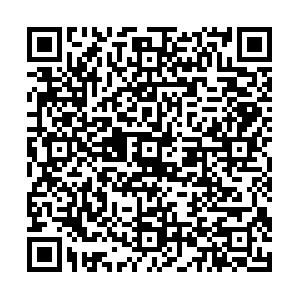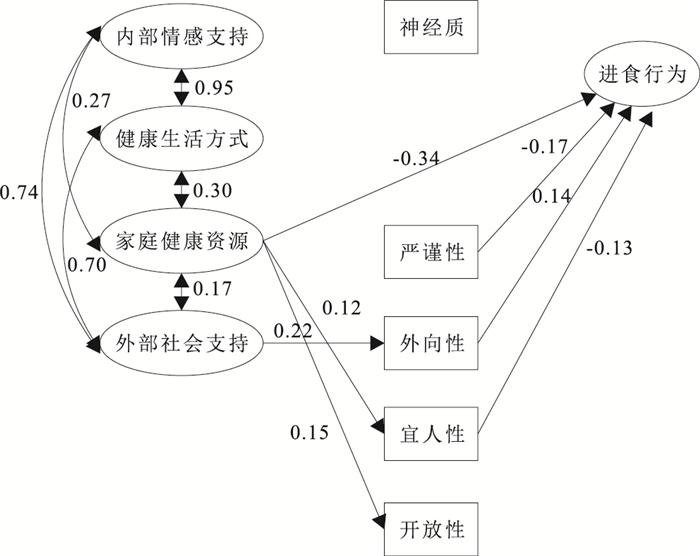Relation of eating behavior and family health and personality traits in adolescents
-
摘要:
目的 探究核心家庭青少年家庭健康功能、人格特质与进食行为之间的关系,为基于人格的青少年不良进食行为易感性预测及家庭干预提供实证支持。 方法 选取“2021年中国家庭健康指数调查”数据中生活于核心家庭的563名12~17岁青少年为研究对象,采用一般资料调查表、家庭健康量表简版、大五人格量表简版、进食行为量表进行调查,采用结构方程模型分析青少年家庭健康功能、人格特质与进食行为之间的关系。 结果 单因素分析显示,不健康家庭、一般健康家庭、健康家庭青少年的大五人格及进食行为得分差异均有统计学意义(P值均 < 0.01)。相关分析显示,青少年家庭健康功能、大五人格及进食行为三者均存在相关关系(P值均 < 0.05)。结构方程模型显示,家庭健康资源、严谨性、外向性、宜人性可直接影响不良进食行为(标准化效应为-0.34,-0.17,0.14,-0.13),家庭健康资源可通过影响宜人性、家庭外部社会支持可通过影响外向性间接影响不良进食行为(标准化效应为0.12,0.22)(P值均 < 0.05)。 结论 核心家庭青少年的家庭健康功能通过大五人格影响进食行为存在直接和间接效应,应重视家庭干预对青少年不良进食行为的改善作用。 Abstract:Objective To explore the relation of eating behavior to family health and personality traits in adolescents, and to provide empirical support for personality-based prediction of adolescents' susceptibility to poor eating behavior and family intervention. Methods A total of 563 adolescents aged 12 to 17 years old from nuclear families, who were selected from "Survey of Chinese Family Health Index(2021)". A general characteristic questionnaire, Short-form of Family Health Scale, 10-item Big Five Inventory, and Short-form of Sakata Eating Behavior Scale were used to collect information. The relationships of eating behavior to family health and personality traits were analyzed by structural equation modeling. Results Group comparison indicated that there was a significant difference in scores of the big five personalities and eating behaviors among adolescents from diverse family health statuses(P < 0.01). Additionally, there were significant correlations among family health, personality traits, and eating behavior(P < 0.01). Structural equation modeling showed that family health resources (-0.34), conscientiousness (-0.17), extraversion (0.14), agreeableness (-0.13) directly affected eating behavior(P < 0.05). Meanwhile, family external social support associated with eating behavior by affecting extraversion (0.22), and family health resources associated with eating behavior by affecting agreeableness(0.12)(P < 0.05). Conclusion Not only could family health directly affect eating behavior, but it could indirectly associate with eating behavior by affecting personality traits among adolescents in nuclear families. The role of the family in improving adolescent poor eating behavior should be emphasized. -
Key words:
- Family /
- Personality /
- Eating /
- Mental health /
- Adolescent
1) 利益冲突声明 所有作者声明无利益冲突。 -
表 1 不同家庭健康状况青少年大五人格与进食行为得分比较(x±s)
Table 1. Comparison of Big Five personality and eating behavior scores among adolescents with different family health status(x±s)
家庭健康状况 人数 开放性 宜人性 神经质 严谨性 外向性 体质认知 进食动机 替代进食 饱腹感 饮食方式 用餐内容 饮食节奏异常 不健康 144 6.81±1.60 6.51±1.27 6.13±1.34 5.85±1.34 6.15±1.60 2.77±0.83 2.39±0.74 2.60±0.71 2.49±0.75 2.66±0.77 2.53±0.70 2.65±0.76 一般健康 183 6.99±1.59 7.11±1.54 5.63±1.56 6.02±1.60 6.15±1.75 2.40±0.98 2.14±0.92 2.54±0.79 2.23±0.84 2.51±0.86 2.44±0.86 2.34±0.89 健康 236 7.50±1.58 7.52±1.42 5.32±1.63 6.34±1.65 6.90±1.94 2.40±0.98 1.96±0.78 2.40±0.84 1.95±0.84 2.22±0.87 2.32±0.89 1.89±0.81 F值 9.94 22.81 12.74 5.03 11.44 11.92 12.45 3.51 20.33 13.52 3.31 40.12 P值 < 0.01 < 0.01 < 0.01 0.01 < 0.01 < 0.01 < 0.01 0.03 < 0.01 < 0.01 0.04 < 0.01 表 2 青少年家庭健康功能、大五人格、进食行为相关性矩阵(r值,n=563)
Table 2. Correlations among family health, personality traits and eating behavior(r, n=563)
变量 家庭健康功能总分 家庭内部情感交流 家庭健康生活方式 家庭健康资源 家庭外部社会支持 饮食节奏异常 饱腹感 饮食方式 家庭内部情感交流 0.677** 家庭健康生活方式 0.638** 0.710** 家庭健康资源 0.655** 0.315** 0.313** 家庭外部社会支持 0.613** 0.517** 0.503** 0.279** 饮食节奏异常 -0.302** -0.228** -0.221** -0.272** -0.237** 饱腹感 -0.239** -0.202** -0.170** -0.247** -0.172** 0.389** 饮食方式 -0.184** -0.069 -0.105** -0.221** -0.148** 0.342** 0.522** 体质认知 -0.146** -0.147** -0.097** -0.148** -0.121** 0.331** 0.348** 0.246** 用餐内容 -0.108** -0.079* -0.058 -0.175** -0.052 0.258** 0.491** 0.371** 替代进食 -0.092** -0.092* -0.026 -0.139** -0.013 0.244** 0.485** 0.318** 进食动机 -0.193** -0.169** -0.155** -0.230** -0.122** 0.329** 0.501** 0.290** 进食行为总分 -0.254** -0.205** -0.180** -0.276** -0.181** 0.611** 0.778** 0.646** 神经质 -0.166** -0.188** -0.139** -0.109** -0.125** 0.205** 0.093* 0.027 外向性 0.147** 0.112** 0.091* 0.086* 0.133** -0.095* -0.015 -0.001 宜人性 0.226** 0.216** 0.157** 0.182** 0.169** -0.218** -0.198** -0.108* 开放性 0.157** 0.106** 0.112** 0.158** 0.101** -0.121** -0.086* -0.081 严谨性 0.089** 0.151** 0.094** -0.002 0.044 -0.099* -0.160** -0.023 变量 体质认知 用餐内容 替代进食 进食动机 进食行为总分 神经质 外向性 宜人性 开放性 用餐内容 0.335** 替代进食 0.350** 0.508** 进食动机 0.297** 0.464** 0.492** 进食行为总分 0.628** 0.711** 0.700** 0.699** 神经质 0.152** 0.056 0.049 0.075 0.141** 外向性 0.019 0.053 0.100* 0.014 0.014 -0.243** 宜人性 -0.045 -0.170** -0.183** -0.232** -0.238** -0.134** 0.108* 开放性 -0.114** -0.100* -0.039 -0.096* -0.135** -0.021 0.227** 0.149** 严谨性 -0.162** -0.176** -0.196** -0.167** -0.206** -0.177** 0.100* 0.266** 0.143** 注: *P < 0.05,**P < 0.01。 -
[1] 国家卫生健康委员会. 中国居民营养与慢性病状况报告(2020年)[J]. 营养学报, 2020, 42(6): 521. https://www.cnki.com.cn/Article/CJFDTOTAL-YYXX202006003.htmNational Health Commission of the PRC. Report on the state of nutrition and chronic diseases in China(2020)[J]. Acta Nutr Sinica, 2020, 42(6): 521. https://www.cnki.com.cn/Article/CJFDTOTAL-YYXX202006003.htm [2] 乞英俊. 儿童青少年肥胖的危险因素和防控措施研究进展[J]. 中国城乡企业卫生, 2020, 35(12): 39-41. https://www.cnki.com.cn/Article/CJFDTOTAL-ZCXW202012015.htmQI Y J. Research progress on risk factors and prevention and control measures of obesity among children and adolescents[J]. Chin J Urban Rural Enterp Hyg, 2020, 35(12): 39-41. https://www.cnki.com.cn/Article/CJFDTOTAL-ZCXW202012015.htm [3] DE ZWAAN M, MITCHELL J E. Opiate antagonists and eating behavior in humans: a review[J]. J Clin Pharmacol, 1992, 32(12): 1060-1072. [4] INTIFUL F D, ODDAM E G, KRETCHY I, et al. Exploring the relationship between the big five personality characteristics and dietary habits among students in a Ghanaian University[J]. BMC Psychol, 2019, 22(7): 1-7. [5] VOLLRATH M E, TORGERSEN S, TORGERSEN L. Associations of children's big five personality with eating behaviors[J]. BMC Res Notes, 2018, 11(1): 654. doi: 10.1186/s13104-018-3768-9 [6] PFEILER T M, EGLOFF B. Personality and eating habits revisited: associations between the big five, food choices, and Body Mass Index in a representative Australian sample[J]. Appetite, 2020, 149: 104607. doi: 10.1016/j.appet.2020.104607 [7] CRANDALL A, WEISS-LAXER N S, BROADBENT E, et al. The family health scale: reliability and validity of a short-and long-form[J]. Front Public Health, 2020, 8: 587125. doi: 10.3389/fpubh.2020.587125 [8] WEISS-LAXER N S, CRANDALL A, OKANO L, et al. Building a foundation for family health measurement in national surveys: a modified delphi expert process[J]. Matern Child Health J, 2020, 24(3): 259-266. doi: 10.1007/s10995-019-02870-w [9] 教育部关于印发《国家学生体质健康标准(2014年修订)》的通知[EB/OL]. (2017-07-07)[2022-06-05]. http://www.moe.gov.cn/s78/A17/twys_left/moe_938/moe_792/s3273/201407/t20140708_171692.html.Notice of the Ministry of Education on the issuance of the national physical fitness standards for students (2014 Revision)[EB/OL]. (2017-07-07)[2022-06-05]. http://www.moe.gov.cn/s78/A17/twys_left/moe_938/moe_792/s3273/201407/t20140708_171692.html. [10] CARCIOFO R, YANG J, SONG N, et al. Psychometric evaluation of Chinese-Language 44-Item and 10-Item big five personality inventories, including correlations with chronotype, mindfulness and mind wandering[J]. PLoS One, 2016, 11(2): e0149963. doi: 10.1371/journal.pone.0149963 [11] 王明忠, 付聪, 周宗奎. "大五"人格、依恋与青少年孤独感的关系研究[J]. 心理学探新, 2015, 35(5): 436-441. https://www.cnki.com.cn/Article/CJFDTOTAL-XLXT201505009.htmWANG M Z, FU C, ZHOU Z K. Research on the relations among big five personality, attachment relationship and adolescents' loneliness[J]. Psychol Explor, 2014, 35(5): 436-441. https://www.cnki.com.cn/Article/CJFDTOTAL-XLXT201505009.htm [12] TAYAMA J, OGAWA S, TAKEOKA A, et al. Item response theory-based validation of a short form of the eating behavior scale for Japanese adults[J]. Medicine(Baltimore), 2017, 96(42): e8334. [13] PODSAKOFF P M, MACKENZIE S B, LEE J Y, et al. Common method biases in behavioral research: a critical review of the literature and recommended remedies[J]. J Appl Psychol, 2003, 88(5): 879-903. doi: 10.1037/0021-9010.88.5.879 [14] 刘凯頔. 家庭结构对老年和青少年健康险需求的影响研究[D]. 济南: 山东财经大学, 2017.LIU K D. Research on the effect of family structure on the demand for health insurance for the elderly and adolescents[D]. Jinan: Shandong University of Finance and Economics, 2017. [15] 秦春莉, 罗炯, 孙逊, 等. 社会资本因素对青少年健康行为的影响研究[J]. 中国体育科技, 2016, 52(2): 105-114. https://www.cnki.com.cn/Article/CJFDTOTAL-ZGTY201602016.htmQIN C L, LUO J, SUN X, et al. Influence of social capital factor on health behavior in adolescents[J]. China Sport Sci Technol, 2016, 52(2): 105-114. https://www.cnki.com.cn/Article/CJFDTOTAL-ZGTY201602016.htm [16] 吕振勇, 郑盼盼, TODD J. 暴食症的影响因素及其机制[J]. 心理科学进展, 2016, 24(1): 55-65. https://www.cnki.com.cn/Article/CJFDTOTAL-XLXD201601006.htmLYU Z Y, ZHENG P P, TODD J. Precipitants and mechanisms associated with binge eating disorder[J]. Adv Psychol Sci, 2016, 24(1): 55-65. https://www.cnki.com.cn/Article/CJFDTOTAL-XLXD201601006.htm [17] 戴杨, 徐通, 马永红, 等. 学龄前儿童饮食行为及其影响因素研究[J]. 中国儿童保健杂志, 2018, 26(3): 243-246. https://www.cnki.com.cn/Article/CJFDTOTAL-ERTO201803005.htmDAI Y, XU T, MA Y H, et al. Study on the status and influencing factors for eating behaviors of preschool children[J]. Chin J Child Health Care, 2018, 26(3): 243-246. https://www.cnki.com.cn/Article/CJFDTOTAL-ERTO201803005.htm [18] 邓文娇, 刘一心, 王虹, 等. 深圳市托幼机构儿童饮食行为影响因素分析[J]. 中国妇幼卫生杂志, 2015, 6(4): 67-69, 80. https://www.cnki.com.cn/Article/CJFDTOTAL-YZWS201504020.htmDENG W J, LIU Y X, WANG H, et al. Analysis on influencing factors of kindergarten children diet behaviors in Shenzhen[J]. Chin J Women Children Health, 2015, 6(4): 67-69, 80. https://www.cnki.com.cn/Article/CJFDTOTAL-YZWS201504020.htm [19] VENTURA A K, BIRCH L L. Does parenting affect children's eating and weight status[J]. Int J Behav Nutr Phys Act, 2008, 5: 15. doi: 10.1186/1479-5868-5-15 [20] 陈琴, 张瑞中, 郭少燕. 家庭喂养方式对青少年儿童肥胖的影响[J]. 中国健康教育, 2017, 33(11): 1024-1027. https://www.cnki.com.cn/Article/CJFDTOTAL-ZGJK201711016.htmCHEN Q, ZHANG R Z, GUO S Y. Influences of family feeding mode on obesity among children and adolescents[J]. Chin J Health Educ, 2017, 33(11): 1024-1027. https://www.cnki.com.cn/Article/CJFDTOTAL-ZGJK201711016.htm [21] KRAL T V, RAUH E M. Eating behaviors of children in the context of their family environment[J]. Physiol Behav, 2010, 100(5): 567-573. doi: 10.1016/j.physbeh.2010.04.031 [22] SNOEK H M, VAN STRIEN T, JANSSENS J M, et al. Longitudinal relationships between fathers', mothers', and adolescents' restrained eating[J]. Appetite, 2009, 52(2): 461-468. doi: 10.1016/j.appet.2008.12.009 [23] ELFHAG K, MOREY L C. Personality traits and eating behavior in the obese: poor self-control in emotional and external eating but personality assets in restrained eating[J]. Eat Behav, 2008, 9(3): 285-293. doi: 10.1016/j.eatbeh.2007.10.003 [24] WU Q T B, MING H. Social capital, family support, resilience and educational outcomes of chinese migrant children[J]. Br J Soc Work, 2014, 44(3): 636-656. doi: 10.1093/bjsw/bcs139 [25] REISS F, MEYROSE A K, OTTO C, et al. Socioeconomic status, stressful life situations and mental health problems in children and adolescents: results of the German BELLA cohort-study[J]. PLoS One, 2019, 14(3): e0213700. doi: 10.1371/journal.pone.0213700 [26] NOVAK D, KAWACHI I. Influence of different domains of social capital on psychological distress among Croatian high school students[J]. Int J Ment Health Syst, 2015, 9: 18. doi: 10.1186/s13033-015-0010-1 -







 下载:
下载:

